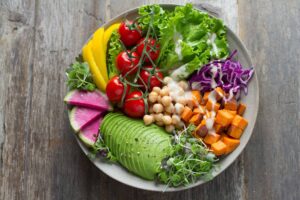The Ketobiotic Diet is a special mix of Keto and probiotics. It combines low-carb and high-fiber to improve health. Keto reduces carbs and burns fat for energy. Probiotics enhance your immune system.
Whether you’re struggling with weight, digestion, or gut health, this diet may be the solution.
Here, I will share its benefits, side effects, and what to eat for a healthier you.
What Is a Ketobiotic Diet?
The Ketobiotc diet is a combination of two popular diets: Ketobiotic and probiotics. Both are poles apart, but blending these diets creates a unique low-carb and high-fiber health plan you can follow.
Ketogenic diet is a low-carb and high-fat diet plan for weight loss that forces your body to switch to ketosis; for energy, the body will burn instead of glucose.
On the other hand, Probiotic foods or supplements improve your immune system. They contain microorganisms, improving good bacteria in the body.
You must begin this Ketobiotic diet by consuming probiotic supplements and slowly increasing the dosage rather than moving to a keto diet plan.
- Numerous diets and exercises don’t work for you
- Too thin and having trouble maintaining a healthy weight
- Experiencing digestive issues
- Diagnosed with a gut health condition
Alternative popular diet: BBBE Diet
Benefits of The Ketobiotic Diet
Ketobiotic diets have various benefits as you’ll stick to healthy food containing high-fiber and low carbs, increasing dopamine neurotransmitters helps improve physical and psychological health.
It helps the production of vitamin B12 to resolve the blood condition known as megaloblastic anemia that weakens your body.
And there are other advantages you are unaware of such as this diet that offers weight loss, enhances gut health, increases energy level, and many more.
Losing Weight
The Wikipedia study confirms that low-carb and high-fat diets improve the amino acid in your body, and executing probiotics increases short fatty acid production. This gradually reduces unnecessary fats and improves digestion while absorbing nutrients, leading to weight loss without weakness.
Improve Metabolic and Gut Health
Consume minimal carbohydrates and high-fiber diet to lower the risk of metabolic and git disease.
This diet first targets lipid profile and blood sugar level, inducing good bacteria and enhancing gut health.
Increase energy levels
Limiting carbs makes your body shift its focus on fat to create energy and push the body to generate ketones naturally. Including foods, drinks or supplements in your diet that are fiber-rich makes good bacteria automatically improve overall health and energy levels.
Fatty-acids Production
Fatty acids are essential for activities in your body by influencing cell metabolism, tissues, and hormonal response.
When your body doesn’t have enough carbohydrates to create energy, it adapts to the ketosis state, which drops the insulin level and releases free fatty acids.
Inflammation Reduction
Ketobiotic foods help good bacteria production digest food and absorb nutrients to release one of the essential ketones, which allows you to monitor ketosis leve;ls known as beta-hydroxybutyrate.
According to Wikipedia, this hormone helps to close the immune system receptor, the leading cause of inflammation.
Boost Immune System
Both bad and good bacteria are present in our body, and the Ketobiotic diet is a perfect plan to boost the immune system.
It reduces oxidative stress, decreases fat mass, stabilizes blood sugar, and promotes immune cell function.
All of this process helps naturally strengthen good bacteria to fight against harmful bacteria.
Promote Brain Function
Neurocognitive decline differs for everyone, but the Ketobolic diet helps to release enzymes produced by muscles-breaking neurotoxins.
The enzymes prevent cell loss in the brain, improving concentration and cognitive function.
Side Effects of Ketobiotic Diet
Losing weight is what most diets promise, but there are some facts linked to harmful health. The ketobiotic diet has some minor drawbacks, too.
So, it should be applied after consulting a doctor or dietician to prevent risks. Moreover, I suggest to avoid this diet plan as it depends on individual needs and health conditions
- Recent surgery
- Weaken immune system
- Severe disease
Headaches: Due to severe diet changes, fluid and mineral balance can shift, which can cause low sodium and potassium.
Dehydration and low energy are also known for headaches; it is better to meditate and drink enough water. You might experience headaches, but consulting a doctor is mandatory.
Fatigue: One standard and short-term effect of this diet is fatigue because of the carbohydrates burning rather than consumed. However, preparing meals with efficient fat and nutrients is better to fuel your body.
Upset stomach: Experiencing gas, bloating or stomach upset are most reported cases in Ketobiotic diet. Although this diet aids in digestion, many probiotic or sudden changes in diet patterns can cause this issue.
The symptoms will gradually disappear as the body gets used to the diet, but you must consult professional help if you experience pain or constipation.
Developing Infection: Following Ketobiotic includes probiotic supplements, which might be cautions for acquiring infection.
A prolonged or severe health condition such as cancer might weaken the immune system. That’s why this diet is not recommended for such people.
Note: You must limit the alcohol, or I suggest entirely avoiding it to stay hydrated and for a better immune system.
Foods You Can Eat and Avoid at Ketobiotic Diet
The Ketobiotoc diet plan is a mixture of two different diets so it is clear that you have to adapt low-carbs meals and fermented foods daily.
Keto diet will help you lose weight, and the probiotic will enhance your gut health while maintaining energy.
However, you must avoid processed foods, starchy vegetables, and sugary delights high in carbohydrates, disturbing your diet plan.
Keeping yourself hydrated so add a large glass of water before each meal, as it dilutes stomach acids.
I have mentioned the complete chart of food items to avoid or add to the daily meal for swift outcomes.
| Foods to Include in Your Meal | Foods to Avoid |
| Kefir | Rice |
| Sauerkraut | Wheat |
| Nuts | Potatoes |
| Avocado | Peas |
| Eggs | Corn |
| Oily fish | Yams |
| Pickles | Sugar loaded items |
| Tempeh | Safflower, sunflower, canola, corn oils |
| Sourdough bread | Red meat |
| Yogurt | Ice creams |
| Kimchi | Baking Items |
Ketobiotic Diet Recipes
Mixing these diets offers the best outcomes to improve gut and overall health. Despite the supplements you can try fermented foods and delicious keto recipes that help you stay energetic and full throughout the day.
Here, I have mentioned the best Ketobiotic diet recipes names that you can enjoy at home while maintaining carbohydrates and fibers.
- Roasted garlic parmesan aioli
- Butternut squash chipotle chili with avocado
- Basil olive bread
- Butternut squash quinoa casserole
- No bake lemon vanilla cream tarts
- Turmeric golden milk
- Chickpea cauliflower butternut squash
You also try : 2468 Diet
Final Verdicts
So there you have it. I love this diet because it offers a range of benefits, from weight loss and improved metabolic health to increased energy levels and reduced inflammation.
Though my recommendation to consult a healthcare professional before starting, especially if you’ve recently had surgery, have a weakened immune system, or have a severe illness.
If you want to give the Ketobiotic diet a shot, the food list and recipe suggestions in this article can assist you in organizing your meals and adding some diversity to your diet.





